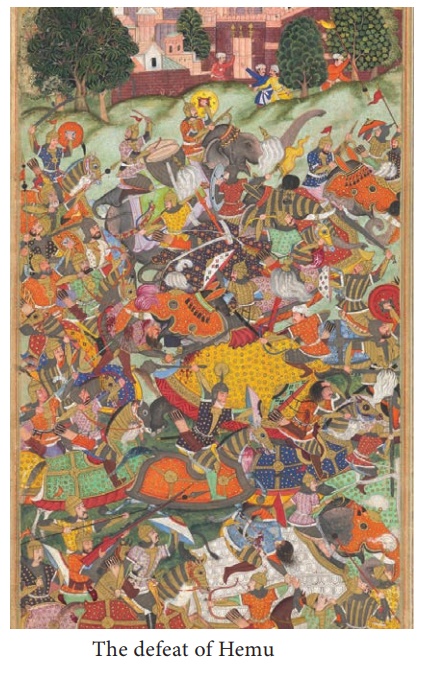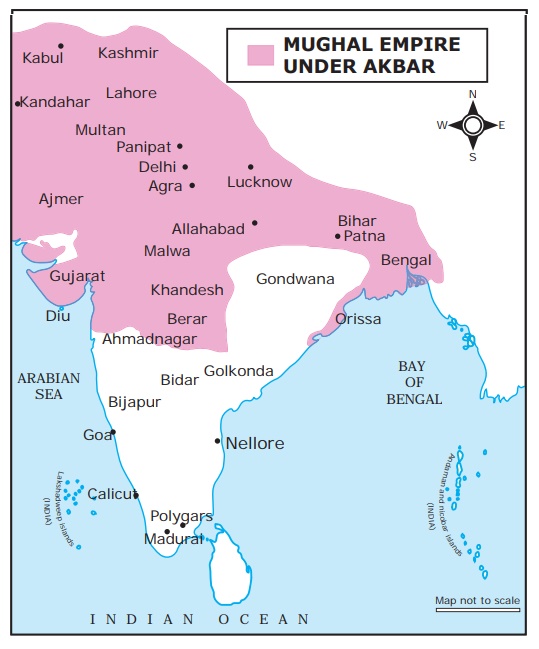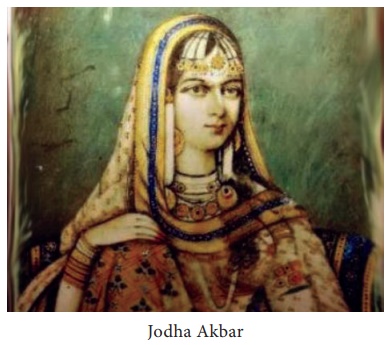The Mughal Empire - Emperor Akbar (1556-1605) | 11th History : Chapter 14 : The Mughal Empire
Chapter: 11th History : Chapter 14 : The Mughal Empire
Emperor Akbar (1556-1605)
Emperor Akbar (1556–1605)
During Humayun’s wanderings in the Rajputana
desert, his wife gave birth to a son, Jalaluddin, known as Akbar, in 1542.
Akbar was crowned at the age of fourteen. At the time of Akbar’s ascension, the
Afghans and Rajputs were still powerful and posed a great challenge. Yet he had
a guardian and protector in Bairam Khan.

Second Battle of Panipat
Hemu, the Hindu general of the displaced Afghan
king Adil Shah, successor of Sher Shah, induced the king to permit him to lead
the Afghan army against

Encouraged by the king, Hemu first
took Gwalior, expelling the Mughal governor. Then he marched on Agra and
captured it without any resistance. Hemu’s generosity helped him to overcome
potential enemies when he took Delhi. In November 1556 Akbar marched towards
Delhi to meet the forces of Hemu in the Second Battle of Panipat. An arrow
struck the eye of Hemu when the battle was likely to end in his favour. The
leaderless Afghan army became demoralised and the Mughal forces emerged
victorious. Hemu was captured and executed. This victory made Akbar the
sovereign of Agra and Delhi and re-establish the Mughal empire.
Akbar and Bairam Khan
As a conqueror Akbar triumphed all over North
India. The first four years of Akbar’s rule saw the expansion of the Mughal
empire from Kabul to Jaunpur, including Gwalior and Ajmer, under his regent
Bairam Khan. Soon Bairam Khan began to behave haughtily towards his fellow
nobles. Akbar, enraged by his behaviour issued a farman dismissing Bairam Khan. This led to Bairam Khan’s revolt
which was ably dealt with by Akbar. Bairam Khan, finally agreeing to submit
himself to Akbar, proceeded to Mecca. But on his way he was murdered by an
Afghan. The family of Bairam khan was brought to Delhi and his son Abdur Rahim
became one of the luminaries of Akbar’s court with the title Khan-e-Khanan.
Akbar’s Military Conquests
Akbar laid the foundation for a great empire
through his vast conquests. Malwa was conquered in 1562 from Baz Bahadur who
was made a mansabdar in Akbar’s court. The Gondwana region of central India was
annexed after a fierce battle with Rani Durgavati and her son Vir Narayan in
1564.The ruler of Mewar, Rana Udai Singh, put up a great fight before losing
Chittor, which was conquered by Akbar after a siege of six months. Rana Udai
Singh retreated to the hills. Yet his generals Jaimal and Patta carried on
their fight. Finally, the generals, along with 30,000 Rajputs were killed. Out
of admiration for the gallant Jaimal and Patta. Akbar honoured them by erecting
statues to their memory outside the chief gate of Agra fort. The capture of
Chittor was followed by the surrender of Rajput states like Ranthambhor,
Kalinjar, Bikaner, Jodhpur and Jaisalmer.

After subordinating the regions of central India,
Akbar turned his attention to Gujarat, a wealthy province renowned for its
maritime commerce. Akbar conquered Gujarat from Muzaffar Shah in 1573. Gujarat
became a launch pad for the annexation of Deccan. After defeating Daud Khan,
the Afghan ruler of Bihar and Bengal, both the provinces were annexed to the
Mughal empire in 1576.
Akbar defeated Mirza Hakim of Kabul with the help of Raja Man Singh and Bhagwan Das. His conquest of Kashmir (1586) and Sindh (1591) consolidated the empire in the northwest.
After achieving the
political integration of North India Akbar turned his attention to the Deccan.
Akbar’s forces had occupied Khandesh region in 1591. In 1596 Berar was acquired
from Chand Bibi, who, as the regent of her nephew Muzaffar Shah, the Nizam
Shahi ruler of Ahmednagar, valiantly defended Ahmednagar against the Mughal
forces of Akbar. By 1600 parts of Ahmed Nagar had fallen into the hands of
Mughal forces. Akbar fell sick in September 1604 and died on 27 October 1605.
Rajput Policy
Akbar took earnest efforts to win the goodwill of
the Hindus. He abolished the jizya
(poll tax) on non-Muslims and the tax on Hindu pilgrims. The practice of sati by Hindu widows was also abolished.
The practice of making slaves of war prisoners was also discontinued. His
conciliatory Rajput policy included matrimonial alliances with Rajput princely
families, and according Rajput nobles high positions in the Mughal court. A
tolerant religious policy ensured the cultural and emotional integration of the
people. Even before Akbar, many Muslim kings had married Rajput princesses. But
Akbar with his broadminded nature was instrumental in these matrimonial
alliances becoming a synthesising force between two different cultures as he
maintained close relations with the families.
Akbar had married Harkha Bhai (also referred to as
Jodha in popular accounts), the daughter of Raja Bhar Mal (also known as Bihari
Mal) of Amber. He also married the Rajput princesses of Bikaner and Jaisalmer.
Prince Salim who was born of Harkha Bhai married the daughter of Raja Bhagwan
Das. Raja Man Singh, son of Bhagwan Das, became the trusted general of Akbar.
Even the Rajputs who chose not to have any matrimonial alliances were bestowed
great honours in Akbar’s court. His Rajput policy secured the services of great
warriors and administrators for the empire. Raja Todar Mal, an expert in
revenue affairs, rose to the position of Diwan. Birbal was a favourite
companion of Akbar.
Mewar and Marwar were the two Rajput kingdoms that
defied the Mughal Empire. After the death of Rana Udai Singh, his son Rana
Pratap Singh refused to acknowledge Akbar’s suzerainty and continued to fight
the Mughals till his death in 1597. The Battle of Haldighati in 1576 was the
last pitched battle between the Mughal forces and Rana Pratap Singh. In Marwar
(Jodhpur), the ruler Chandra Sen, son of Maldeo Rathore, resisted the Mughals
till his death in 1581, though his brothers fought on the side of the Mughals.
Udai Singh, the brother of Chandra Sen was made the ruler of Jodhpur by Akbar.
Akbar’s capital was at Agra in the beginning. Later he built a new city at
Fatehpur Sikri. Though a deserted city now, it still stands with its beautiful
mosque and great Buland Darwaza and many other buildings.

Mansabdari System
Akbar provided a systematic and centralised system
of administration which contributed to the success of the empire. He introduced
the Mansabdari system. The nobles, civil and military officials combined into
one single service with each officer receiving the title of Mansabdar.
Mansabdar rank was divided into Zat and Sawar. The former determined the number
of soldiers each Mansabdar received ranging from 10 to 10,000. The latter
determined the number of horses under a Mansabdar. Each officer could rise from
the lowest to the highest ranks. Promotions and demotions were made through
additions or reductions of Mansabs. The Mansabdari system diversified the
ethnic base of his nobility. During Akbar’s early years the nobles were drawn
exclusively from Central Asians or Persians. But after the introduction of the
Mansabdari system, the nobility encompassed Rajputs and Shaikhzadas (Indian
Muslims). The salary of a Mansabdar was fixed in cash but was paid by assigning
him a jagir (an estate from which he could collect money in lieu of his
salary), which was subjected to regular transfers. The rank of Mansabdar was
not hereditary and immediately after the death of a Mansabdar, the jagir was
resumed by the state.
Akbar’s Religious Policy
Akbar began his life as an orthodox Muslim but
adopted an accommodative approach under the influence of Sufism. Akbar was
interested to learn about the doctrines of all religions, and propagated a
philosophy of Sulh-i-Kul (peace to all). Badauni, a contemporary author, who
did not like Akbar’s inter-religious interests, accused him of forsaking Islam.
Akbar had established an Ibadat Khana, a hall of worship in which initially
Muslim clerics gathered to discuss spiritual issues. Later he invited
Christians, Zoroastrians, Hindus, Jains and even atheists to discussions.
In 1582, he discontinued the debates in the Ibadat
Khana as it led to bitterness among different religions. However, he did not
give up his attempt to know the Truth. Akbar discussed personally with the
leading lights of different religions like Purushotam and Devi (Hinduism),
Meherji Rana (Zorastrianism), the Portugese Aquaviva and Monserrate
(Christianity) and Hira Vijaya Suri (Jainism) to ascertain the Truth. Because
of the discussions he felt that behind the multiplicity of names there was but
one God. The exact word used by Akbar and Badauni to illustrate the philosophy
of Akbar is Tauhid-i-Ilahi namely Din Ilahi. Tauhid- i-Ilahi literally meant
divine monotheism.
It can be considered a sufistic order but not a new
religion. He had become a Pir (Sufi Guru) who enrolled Murids (Sufi disciples)
who would follow a set pattern of rules ascribed by the Guru. Thousands of
disciples enrolled as his disciples. Akbar’s intention was to establish a state
based on the concept of secular principles, equal toleration, and respect to
all sections irrespective of their religious beliefs. He set up a big
translation department for translating works in Sanskrit, Arabic, Greek, etc,
into Persian. The Ramayana, Mahabharata, the Atharva Veda, the Bible and the
Quran were translated into Persian. The Din Ilahi ceased to exist after Akbar.
Related Topics